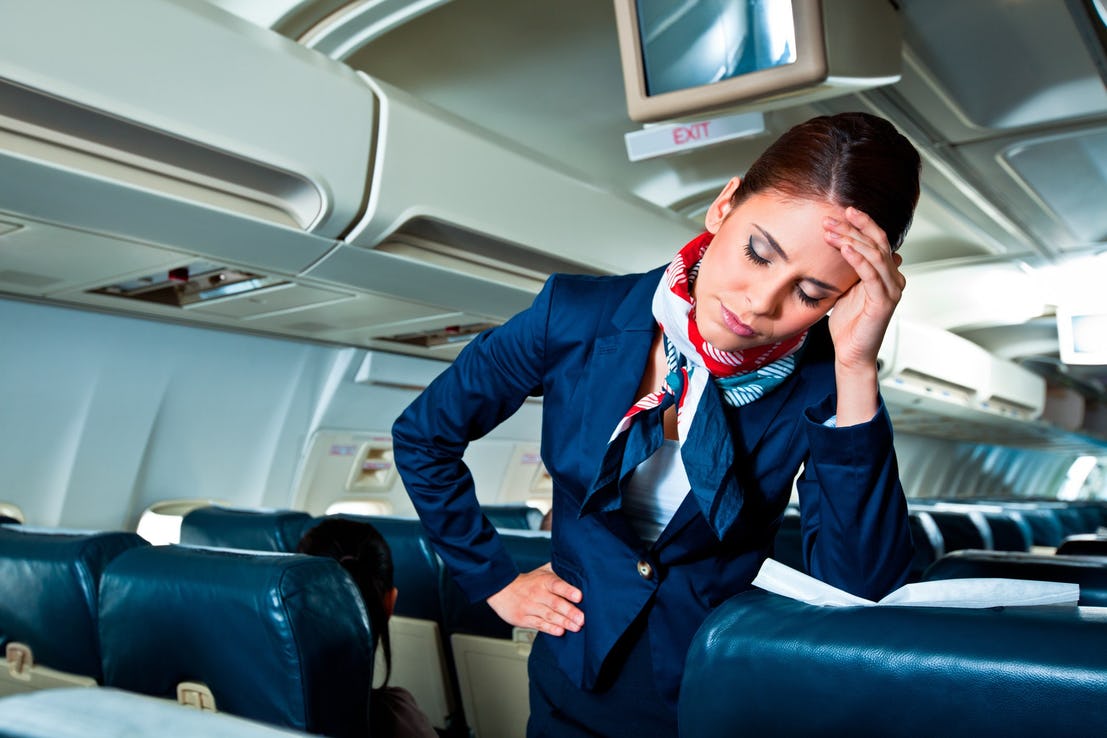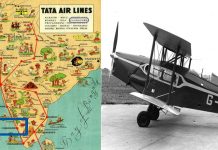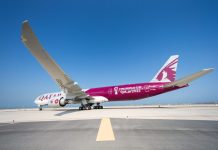19 Emergency Codes Only Airline Personnel Will Recognize
To keep travelers calm and collected, there are secret codes known by the pilot, control tower, and flight attendants. Let’s find out what they are.
19 SQUAWK IT UP
 In order to talk about these secret phrases and codes used by the airlines and airports, it’s important to understand some terminology first. The first word to understand is “squawk” or “squawk code.” Squawk codes are a discrete, four-digit system of numbers used to communicate via the transponder.
In order to talk about these secret phrases and codes used by the airlines and airports, it’s important to understand some terminology first. The first word to understand is “squawk” or “squawk code.” Squawk codes are a discrete, four-digit system of numbers used to communicate via the transponder.
The codes are assigned by air traffic control to a plane, to uniquely identify the flying craft.
The pilots exchange these codes with the tower for a number of reasons. Often, they are used with one another to convey emergency situations, mechanical failures, disruptions and other problems aboard the flight or on the ground.
18 ALERT THE AUTHORITIES

Obviously, every situation regarding airplanes and airports, good or bad, is going to have a ton of variation. In order for crew and ground personnel to effectively handle a situation, it’s vital they know as much information about the event as possible. This info also has to be communicated as quickly as possible.
This is why the Federal Aviation Administration (FAA) has developed airport emergency plans with various phases. These are called “alerts.” The alerts follow a numerical system that describes the type of scenario and could be anything from a minor problem to a major event. There are 4 of these alerts.
17 SOULS ABOARD

According to the TSA, 2004 had the single busiest travel day in US history, with over 2.7 million travelers. Air travel continues to be one of the most popular modes of transportation, and Summer of 2018 is set to beat the record for domestic travel.
With the exorbitant number of crew and passengers frequenting airports, the different alerts have levels based on the number of people affected by whatever event occurs.
The alerts are broken into 5 levels, that distinguish the number of “souls” involved. Level 1 describes an event that would injure or affect only one or two souls. And the highest number, Level 5, is a bulk of 51 or more people.
16 ALERT 1

Now that you understand a bit of terminology, let’s get into the nitty-gritty. The fun stuff, or not so fun stuff (if you’re one of the unfortunate souls on the plane). Let’s talk a little more in-depth about the alert system that we previously discussed. Alert codes, as mentioned, give important indicators to the pilot and crew.
Alert 1 is the lowest level, and indicates minimal cause for panic (so sit back and enjoy the flight). It’s usually a reference to mechanical failure or electrical issues. When this signal is given the airport is notified to alert the local fire department, giving them an advanced warning to be at the ready.
15 ALERT 2

The situation starts heating up when an airplane sends the signal for Alert 2. This alert is like a ramped up version of Alert 1. It still refers to some sort of mechanical or electrical malfunction or failure, but in this case, the circumstance is dire.
If you hear Alert 2 muttered by a passing flight attendant, put down your peanuts and tighten your seatbelt.
When this alert is given, fire departments aren’t just notified to be ready but are directed to meet the plane on the tarmac. This is actually more common than you might expect, as planes often have mechanical malfunctions.
14 ALERT 3

Alert 3 should give you a little peace of mind because it refers to a different plane other than the one you’re on. If the radio in the cockpit voices Alert 3, that means a plane has crashed at or near an airport. This could cause delays or destination changes to your flight.
When you hear talk of Alert 3, they may also reference the level system that we mentioned earlier. So if you hear “Alert 3, Level 4,” that means a plane crashed nearby and somewhere between 26 to 50 souls were affected. This could mean passengers, crew or people on the ground.
13 ALERT 4

The final alert in the alert code system is Alert 4. This is the most extreme level and, should you hear it, we recommend running for the exits…unless you’re mid-flight. Alert 4 signals the air control tower and ultimately the authorities that a serious emergency (like a hijacking) is impending.
This is definitely cause for concern, and no matter how the airline attendant tries to cover their fear with an agreeable smile, it’s time to be alarmed.
Unless you are on an incredibly small, private plane, this alert will probably be called out as “Alert 4, Level 5,” because it will affect many people, both on the ground and in the air.
12 SQUAWK 7700

To delve a little deeper into the squawk codes we already talked about, let’s take a look at one of the three most important. These three codes are recognized worldwide as emergency signals and are taken very seriously. The first, and most general, is squawk 7700.
This code is communicated more often then you might expect and is simply a declaration of an in-air emergency. When this signal is sent out, it’s not clear what event has occurred, but the air traffic control tower will immediately give directions to the nearest airfield. This could be anything from engine failure, smoke detected, or low fuel.
11 SQUAWK 7600

When pilots fly, they use numerous forms of technology to “see” where they’re going. Although there is a huge windshield at the front of the plane, much of the navigation is performed with charts, GPS, computerized maps, radar and, of course, radio communication.
But just like your cell phone can have problems dropping calls, running out of battery, or losing signal, airplanes can run into radio failure.
When squawk 7600 goes out, it means the plane has a loss of communication with the tower. At this point, air traffic control will use old-fashioned methods to safely land the plane on the runway. They will vidual cues to the pilot, using light for landing signals.
10 SQUAWK 7500

The most imminent squawk is similar to Alert 4. While an alert is transmitted via radio, squawk 7500 is delivered via transponder, with the same result. If you find out about squawk 7500, it means a high-jacking is in progress or probable. This code is obviously given immediate attention and is recognized worldwide.
Flying is a stressful endeavor, but don’t let these codes stop you from air travel. Hijacking, although serious, is very rare in comparison to the number of flights in and out of airports on a daily basis. The last known hijacking of a plane was in April of 2018 with Air China, and there is generally only one of these events per year.
9 MAYDAY

Everyone is probably a little familiar with the term mayday, which can be used by aircraft, boats, firefighters and police. The vocal distress signal dates back to 1923 and stems from the French word “m’aider,” which means “help me.”
The phrase is only to be used in absolutely life-threatening situations, such as a likely plane crash.
When this signal is stated, it is always meant to be said in a repetition of threes (mayday, mayday, mayday), so there is no confusion. The mayday signal will garner an immediate response from the tower, and help will be provided if possible. The mayday can also be sent by another vessel that knows a plane is in distress.
8 LAST MINUTE PAPERWORK

If you’ve traveled recently by air, you’re probably familiar with the basic in-flight procedures, such as stowing your baggage, turning off electronic devices, and ignoring the flight attendants emergency announcements. You might also be familiar with the pilot making an announcement regarding finishing up some “last minute paperwork.”
This phrase is actually a secret code to communicate with the crew onboard to expect delays before takeoff. In general, there’s no paperwork involved, but you can expect to be waiting in your seat before the plane heads down the runway. The delay can be anything from improper plane weight to mechanical failures, maintenance checks or even an unruly passenger. Just because they say this, doesn’t mean there’s cause for alarm.
7 TRIANGULAR TROUBLES

In the very rare occurrence that a plane loses all ability to communicate, there are last-resort plans for emergencies. One of these pre-planned communication signals is flying in a triangular distress pattern.
If you’re enjoying the latest in-flight movie, and suddenly feel the plane making repetitive sharp turns, this may be the pilots attempt to signal for help.
This triangular distress pattern consists of persistent 120 degree turns, creating a triangle shape in the air. This only happens if radio communication is no longer an option. As mentioned, this is an incredibly rare procedure, and chances are a pilot would opt to just communicate via the transponder.
6 FASTEN YOUR SEATBELTS

Nothing will instill fear in a passenger more than when a plane hits turbulence. Sometimes the bumps in travel are small enough to brush off and ignore while you watch the most recent season of Game of Thrones on your seatback tv. While other times, the turbulence sends your free soda and in-flight snack flying through the air.
When you hear an announcement over the intercom that your set to hit an air pocket, it’s time to buckle up. Conditions are about to get bumpy and you should fasten your seat belt. This usually will pass, and is not something to fear. But there have been some cases where heavy turbulence caused structural damage and crashes.
5 PETER PAN-PAN

Pan-pan isn’t a reference to following the second star on the right and straight on ’til morning. It’s actually another verbal signal, very similar to mayday.
This signal is also communicated to the tower over the radio and is a broad declaration of an emergency situation.
Pan-pan comes from the French word “a panne,” and now has an acronym meaning “possible assistance needed” or “pay attention now.” It’s an urgent signal but doesn’t necessarily mean a wreck is likely. There is also an equivalent alert used with Morse code and is represented by XXX. Each of these signals or recognized internationally.
4 CODE ADAM

Airports are a bustling hub of activity. The busiest US airport is Hartsfield-Jackson Atlanta International Airport in Georgia, with over 100 million travelers passing through each year. With all the people coming and going, parents should take extra care to keep an eye on young children (maybe using one of those leashes if your kid is extra adventurous).
If you’re at an airport and hear the phrase “Code Adam,” it means a child is missing or has been abducted. The name of this code comes from a department store case in 1981 when a 6-year-old boy was kidnapped. This boy was the son of John Walsh, the host of the TV show America’s Most Wanted.
3 CODE BRAVO

If you’ve ever been at an airport and heard “freeze” yelled by some member of TSA, you can be sure everyone’s heart starts racing. You might also hear an announcement of “Code Bravo,” which is meant to declare a general alert to security.
Although it can be scary, often times this is nothing more than a drill.
The goal of security hollering one of these key phrases is sometimes in an attempt to catch a threatening person. The assumption is that most good travelers will obey the signal, and wait until any danger has passed. While a potential criminal will take off, in an attempt to avert the authorities.
2 AREA OF WEATHER

When it comes to air travel, weather can be a huge detriment. Events like tornados, snow, ice and heavy winds can cause major delays and ruin the travel experience. Holiday travel during the winter season can be incredibly frustrating, with thousands of flights nationwide being delayed or completely canceled.
If you’re on a plane and hear the pilot make an announcement regarding an “area of weather,” you’re in for some delays and possibly even danger. Area of weather eludes to lightning, thunder and heavy rains. These weather-related events can result in changes to the flight pattern, new landing destinations, damage to the plane exterior and delays in your travel plans.
1 SIN BIN

There’s nothing worse than squeezing into your middle seat between someone who has never heard of deodorant, and another person who doesn’t understand personal space. Traveling on a plane is already a crummy experience unless you have a personal jet.
But the bad experience is exacerbated if you hear a flight attendant mutter the words “sin bin.”
This isn’t a code word for a quick trip to Vegas, but a term used to say that the runway is over-crowded. Although it doesn’t signify danger (unless the pilot decided to disregard and land the plane anyone), you can certainly expect a lengthy delay before landing or takeoff.
Sources: aerosavvy.com, heraldsun.com, airandspace.si.edu, forums.radioreference.com.



















